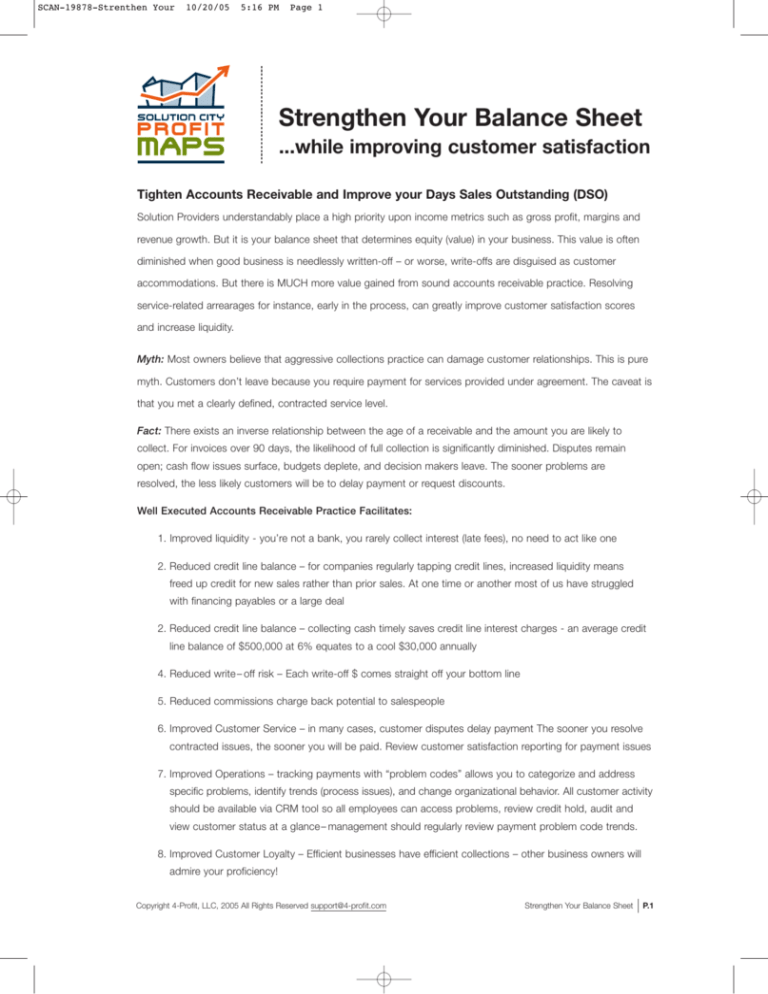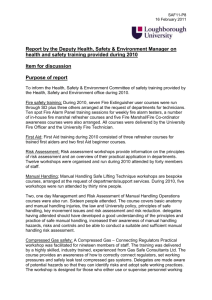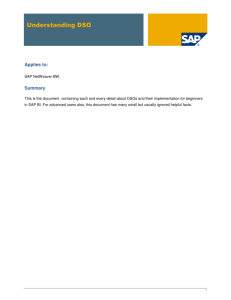
SCAN-19878-Strenthen Your
10/20/05
5:16 PM
Page 1
Strengthen Your Balance Sheet
...while improving customer satisfaction
Tighten Accounts Receivable and Improve your Days Sales Outstanding (DSO)
Solution Providers understandably place a high priority upon income metrics such as gross profit, margins and
revenue growth. But it is your balance sheet that determines equity (value) in your business. This value is often
diminished when good business is needlessly written-off – or worse, write-offs are disguised as customer
accommodations. But there is MUCH more value gained from sound accounts receivable practice. Resolving
service-related arrearages for instance, early in the process, can greatly improve customer satisfaction scores
and increase liquidity.
Myth: Most owners believe that aggressive collections practice can damage customer relationships. This is pure
myth. Customers don’t leave because you require payment for services provided under agreement. The caveat is
that you met a clearly defined, contracted service level.
Fact: There exists an inverse relationship between the age of a receivable and the amount you are likely to
collect. For invoices over 90 days, the likelihood of full collection is significantly diminished. Disputes remain
open; cash flow issues surface, budgets deplete, and decision makers leave. The sooner problems are
resolved, the less likely customers will be to delay payment or request discounts.
Well Executed Accounts Receivable Practice Facilitates:
1. Improved liquidity - you’re not a bank, you rarely collect interest (late fees), no need to act like one
2. Reduced credit line balance – for companies regularly tapping credit lines, increased liquidity means
freed up credit for new sales rather than prior sales. At one time or another most of us have struggled
with financing payables or a large deal
2. Reduced credit line balance – collecting cash timely saves credit line interest charges - an average credit
line balance of $500,000 at 6% equates to a cool $30,000 annually
4. Reduced write – off risk – Each write-off $ comes straight off your bottom line
5. Reduced commissions charge back potential to salespeople
6. Improved Customer Service – in many cases, customer disputes delay payment The sooner you resolve
contracted issues, the sooner you will be paid. Review customer satisfaction reporting for payment issues
7. Improved Operations – tracking payments with “problem codes” allows you to categorize and address
specific problems, identify trends (process issues), and change organizational behavior. All customer activity
should be available via CRM tool so all employees can access problems, review credit hold, audit and
view customer status at a glance – management should regularly review payment problem code trends.
8. Improved Customer Loyalty – Efficient businesses have efficient collections – other business owners will
admire your proficiency!
Copyright 4-Profit, LLC, 2005 All Rights Reserved support@4-profit.com
Strengthen Your Balance Sheet
P.1
SCAN-19878-Strenthen Your
10/20/05
5:16 PM
Page 2
Formula: Accounts Receivable Industry Metric: Days Sales Outstanding (DSO):
Accounts Receivable x 365 Divided by Annual Revenue
Benchmark
We are often asked about DSO across the IT industry. While several benchmarks do exist ranging generally
from 54-61 day DSO’s, when looking at 2 specific companies, it is often an apples to oranges comparison.
Certain application developers for example, have 30 day DSO’s (or less) as mission critical systems can be shut
down for non-payment – now that’s leverage! A 35 day or better DSO performance is achievable for nearly every
business model we’ve reviewed and it can happen in as little as 60 days. The key is to sustain performance
using best practices.
Billing Best Practices for collecting funds owed your company:
• Pay close attention to major billings (rolling) on a daily basis. Review customer balances over a set credit
“limit” per client. Secure payment arrangements as leverage when new orders are received.
• Create billing policy and measure billing accuracy (eg: monthly number of invoice corrections required and
quarterly customer satisfaction rating for billing accuracy)
• Efficient and timely billing is important to timely collections – consider 50% or a minimum 33% billed upon
customer contract signature rather than install
Accounts Receivable Best Practice for collecting funds owed your company:
• Follow up should be made between 32 and 35 days on Net 30 terms - request payment date and
follow-up with your customer! For known payment delays, be sure to call on ALL subsequent follow
up dates – TIMELY FOLLOW UP IS CRITICAL FOR ESTABLISHING SOUND AND CONSISTENT
COLLECTIONS PRACTICE
• Make introduction call on large dollar invoices confirming receipt and invoice validity – A/R relationships
are especially important in businesses with recurring client revenue – including CFO’s and owners. You’re
A/R department should be well trained in billing, contracts, policies, and have excellent communications
and problem resolution skills to take as little time away from sales and service as possible - revenue
generation is a far better use of time than revenue recovery
• Create written collections and credit policies and process which include cooperation (eg. 3 way calls to
resolve issues), commission’s charge backs, credit hold (eg. pre-paid maintenance required for problem
T&M payers), accommodation levels, PO requirements and write-off policy (as needed)
• Create accountability/empowerment for resolution at pre-defined $ levels
• Use phone and email as opposed to letters for regular A/R process. Use letters for significantly delayed
accounts for paper trail
• Electronic invoicing – most software packages support electronic invoicing or via .pdf (at a minimum for
high $ invoices)
• No equipment installed before a Purchase Order (PO) is received - especially common in large account or
gov’t contracting – resist the urge!
Copyright 4-Profit, LLC, 2005 All Rights Reserved support@4-profit.com
Strengthen Your Balance Sheet
P.2
SCAN-19878-Strenthen Your
10/20/05
5:16 PM
Page 3
• Invoices must be at or below PO amount (audit process) especially for gov’t – description on invoice must
match PO as required by customer
• Consider leasing or increased leasing – Improved DSO and commissions may be earned from leasing and
off lease opportunities through leasing companies
• Accounts Receivable is usually handled by accounting. But introverted accounting personality types are
often unsuitable for calling customers and requesting money. Profiling such as DISC testing can assist.
Consider a customer service person or potentially a dual role if part-time in smaller companies
• Review process change where possible to avoid salesperson involvement. While it is often required,
strengthening process issues such as contracting, documenting PO’s and efficient communication can
keep salespeople selling new business rather than collecting on the old. Review collections “problem
codes” for such trends and take corrective process and / or individual action.
• Accept payment by phone, ACH and credit cards (especially for payment plans)
• Request overnight payments or check numbers over the phone - to verify payment. In some cases
you may wish to pick up checks at customer location
The following strategies can lower DSO in practice:
• Prepaid contracts - maintenance or other project and /or recurring revenues
• Contract terms (less than Net 30)
• Aggressive invoice discounting/credit practices – credits are really the same as write-offs – be sure your
customer satisfaction credits are justified
• Leasing and/or manufacturer/distributor financing arrangements
• Billing upon installation versus contract signature (we recommend the latter)
• Factoring receivables – we generally don’t recommend factoring as it is very costly in fees, customer
service (others calling your customers) and market perception
• Payment schedule in place for all contracts
• For equipment resellers, be sure to have a REGULAR and CONSISTENT system for follow up for
replacement equipment under warranty or contract. Be sure to notify a customer in advance that a
replacement equipment invoice is credited only when defective equipment is received.
• Efficient credit process - use outstanding invoices as leverage when client requests new services – be sure
to include requested service in your collections. Dispatch, for example will need access to customer profile
to determine credit hold before service is authorized.
• Outsourced collections – large issues or those with bankruptcy potential, suit and / or early notification of
non-payment intentions should be considered. Generally, contingent collections fees will cost between
25-50% and agencies/attorneys are provided “settlement authority” lowering the amount you receive less
the fee.
Copyright 4-Profit, LLC, 2005 All Rights Reserved support@4-profit.com
Strengthen Your Balance Sheet
P.3
SCAN-19878-Strenthen Your
10/20/05
5:16 PM
Page 4
• UCC-1 filing - A signed UCC-1 establishes you as a “secured creditor” and allows for equipment recovery
and other protection in a non-payment, failure or bankruptcy or until the debt is settled. As a secured
creditor, you move to the head of the class for distributions in the event of a Chapter 7 or 11 bankruptcy.
For large installations of equipment for example, with a risky buyer financing yourself (not recommended),
consider filing a UCC-1 with the state as a provision within your contract. Be sure to maintain all
equipment serial numbers.
• Consider other forms of payment. For start-ups and high risk companies, risk takers may accept noncash, options, equity or other forms of barter for services and equipment.
Create incentives for strong DSO (and billing) Performance:
Calculate DSO for each of the previous 3 months using the DSO metric above. Take the average of the 3
months. Then use a rolling 3 month average DSO going forward. A 3 month average is used to “smooth” a
month with an extraordinary invoice. Consider incentives according to starting DSO and desired goal(s). Some
companies create incentives by 30,60,90 day aging buckets but this incentive doesn’t always drive behavior
towards a DSO goal of 30 days (or your payment terms).
You might also consider incentives for “process improvements” identified within your company. Once you track
problem codes for receivables matters, for instance, you can identify process problems and create incentives
for “fixing” the core issues. For instance, you have 8 inaccurate invoices per month due to incorrect tax rates
or tax exemptions delaying payment. Each invoice resolution takes 30 minutes to resolve. That’s 4 hours per
month and 48 hours per year. What is that worth to you as an incentive to fix the process?
Billing accuracy and accounting efficiency should incorporate improvement and process incentives through
percentage of accuracy and customer satisfaction measurement (goal of 98% satisfied in billing accuracy).
Set baselines according to customer satisfaction measurement and seek to drive goal setting and performance
against progressive goals.
Conclusion:
Strong DSO is tied to strong liquidity and is an enabler towards improved customer satisfaction. Both metrics
tie closely to efficient process and productivity improvement. While you can lower your DSO in a relatively short
period, the factors causing payment delay will often take longer as you review your soup to nuts business
process. In most cases, it is a very worthwhile pursuit and critical to companies seeking profitable growth.
DSO certainly isn’t a sexy metric. But your banker will love it and so will your bottom line! Business guru’s preach
that businesses succeed when revenues exceed expenses. In actuality, business succeeds when cash received
exceeds liabilities and expenses paid. Revenue earned must convert to cash on hand. Businesses generally fail
when they run out of cash.
Copyright 4-Profit, LLC, 2005 All Rights Reserved support@4-profit.com
Business Strengthen Your Balance Sheet
P.4










